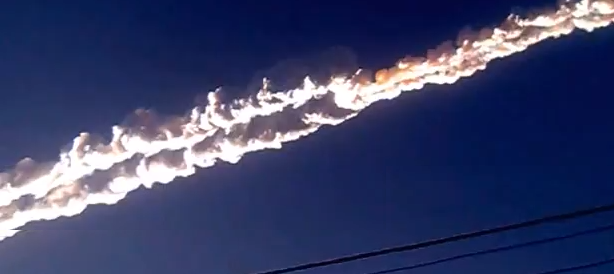Chelyabinsk event – 20m wide asteroid explodes above Russia, damaging 3 000 buildings and injuring over 1 500 people

A very bright flash was seen in the Chelyabinsk, Tyumen and Sverdlovsk regions, Russia’s Republic of Bashkiria, as well as in northern Kazakhstan, early morning local time on February 15, 2013. The flash was accompanied by a very loud explosion. Officials mention meteor shower and say that it began after a large meteorite disintegrated above the Urals mountain range and partially burned up in the lower atmosphere – resulting in fragments falling earthwards throughout the Chelyabinsk region.
“According to preliminary estimates, this space object is of non-technogenic origin and qualifies as a meteorite. It was moving at a low trajectory with a speed of about 30 km/s,” Russian space agency Roskosmos said.
At least one piece of the fallen object caused damage on the ground in Chelyabinsk. According to preliminary reports, it crashed into a wall near a zinc factory, disrupting the city’s Internet and mobile service.
During the morning, the Russian military discovered 6 m deep crater with normal background radiation.
Russian Academy of Science said the meteorite weighed about 10 tons before it entered Earth’s atmosphere. Lifenews reported, quoting a source in the Emergencies Ministry, that before falling to earth, the meteorite exploded nine times, starting at an altitude of 55 km.
2 962 buildings were damaged, including 34 healthcare facilities, 11 social security institutions, and 361 school and pre-school educational institutions. The damage is estimated at more than $13 million.
More than 1 500 people were injured – mostly by broken glass.
This is the biggest asteroid outburst since the 1908 Tunguska event and the only asteroid confirmed to have resulted in a large number of injuries.
Residents of the town of Emanzhilinsk, some 50 km from Chelyabinsk, said they saw a flying object that suddenly burst into flames, broke apart and fell to earth, and that a black cloud had been seen hanging above the town. Witnesses in Chelyabinsk said the city’s air smells like gunpowder.
Oleg Malkov, an aerospace scientist at Moscow State University, told Komsomolskaya Pravda newspaper that the meteorite went undetected by space scanners, likely because it was coming from the direction of the Sun.
“We can only register stones coming from the direction of the night sky,” he explained. Malkov confirmed that the meteor shower in the Urals was not connected to the 2012 DA14 asteroid that will approach Earth in a few hours.
The Mayak nuclear complex near the town of Ozersk was not affected by the incident, according to reports. Mayak, one of the world’s biggest nuclear facilities that used to house plutonium production reactors and a reprocessing plant, is located 72 km northwest of Chelyabinsk.
NASA has also said that today’s fireball over Russia had nothing to do with asteroid 2012 DA14: “The trajectory of the Russian meteorite was significantly different than the trajectory of the asteroid 2012 DA14, making it a completely unrelated object. In videos of the meteor, it is seen to pass from left to right in front of the rising sun, which means it was traveling from north to south. Asteroid DA14’s trajectory is in the opposite direction, from south to north.“
What’s also interesting is that another fireball was also reported over the sky of Japan yesterday (February 14, 2013).
A huge fireball was reported over Belgium, Netherlands and Germany on February 13, 2013, but it appears to be a part of the Soyuz rocket launched on February 11 to ISS.
Late UTC afternoon on February 15, 2013, people from Cuba apparently witnessed another bright fireball exploding over the town in the province of Cienfuegos.
Featured image: Trail left by Chelyabinsk meteor on February 15, 2013

[…] image Source: thewatchers.adorraeli.com […]
This image may explain the two different trajectories better — even though it was found at a site known for conspiracy theories, so take it with a grain of salt for now, that is until NASA or ESA post a similar image to be found.
http://files.abovetopsecret.com/files/img/tt511e7233.jpg
Those caught in the glare of the Sun are the ones that can sneak up on us, as this one was about one third the size of asteroid 2012 DA14 but travelling in from nearly the opposite direction, thus unrelated to each other.
Impressive videos! When should we expect the bigger one mentionned in a comment above?
There is always the possibility that larger meteorites hit the Earth. Are the governments doing everything they could to create technologies to detect and destroy these meteorites before they hit the ground?
The fireball that was seen in the netherlands, belgium and germany was part of a sojoez rocket, so a man made fireball 🙂
[…] locals have speculated that it was a military fighter jet crash or a missile explosion. More at https://watchers.news/201…eople-injured/ __________________ – – Jim "Life is like riding a bicycle. To keep your balance you […]
Asteroids almost always travel in groups. So it is no brainer that it is related to the bigger one coming in for a close pass.
What would be next? Yesterday ironically I was looking at a video about meteorites, it is this just the begin of those meteorites shower?
That was an impressive entry and blast witnessed by many in Mother Russia as youtube videos pour in to report what caused the blast.
[…] Meteor shower reportedly hits Russia and Kazahstan, over 500 people injured […]